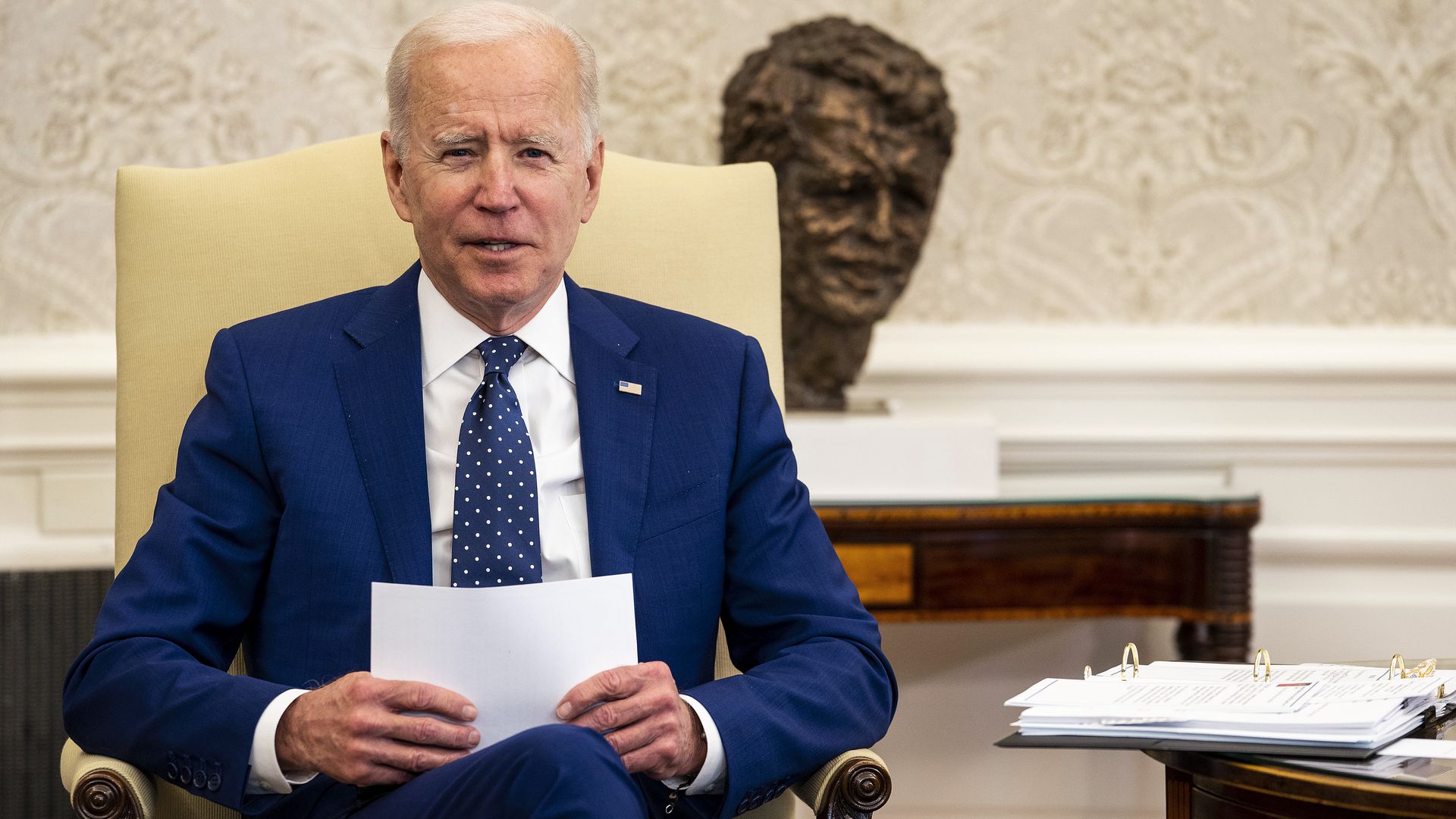This article is more than
3 year oldBiden pledges to cut greenhouse gas emissions by up to 52% by 2030

The Biden administration is moving to address global warming by setting a new, economy-wide greenhouse gas emissions reduction target of 50% to 52% below 2005 levels by 2030.
Why it matters: The new, non-binding target is about twice as ambitious as the previous U.S. target of a 26% to 28% cut by 2025, which was set during the Obama administration. White House officials described the goal as ambitious but achievable during a call with reporters Tuesday night.
- President Biden unveiled the goal during the opening remarks of a virtual climate summit the White House is hosting on Thursday, which will feature at least 40 heads of state, including China's President Xi Jinping, as well as business executives and Pope Francis.
- "This is a moral imperative, an economic imperative. A moment of peril but also a moment of extraordinary possibilities," Biden said in his address. "Time is short but I believe we can do this and I believe that we will do this."
The big picture: The new 2030 target is meant to keep the U.S. on a path that would be likely to limit global warming to just 1.5 degrees Celsius (2.7 Fahrenheit) above preindustrial levels by 2100.
- This is the more stringent target contained in the Paris Climate Agreement, which would be more likely to avoid some of the worst effects of climate change.
- Right now, the world is on course to see around 3 degrees Celsius (5.4 Fahrenheit) of warming by 2100.
The target is also aimed at convincing the world — which watched as former President Trump attacked and abandoned the Paris deal — that the U.S. is not only back in the agreement, but a a leader in global climate efforts.
- "The United States is not going to wait. The costs of delay are too great, and our nation is resolved to act right now," an administration official told reporters on Tuesday night's call.
- Another official said it should provide "significant leverage" for pushing for climate action from other countries.
How it works: Meeting the target will require sweeping changes across the U.S. economy, including decarbonizing the power sector, dramatically scaling up the share of electric vehicles on the road, along with large gains in energy efficiency for buildings, among other measures.
- Levers at policy makers' disposal include everything from tax credits for deploying renewable energy systems and purchasing electric vehicles to regulatory actions.
- According to Nathan Hultman, director of the Center for Global Sustainability at the University of Maryland, about 75% of all reductions may come from the electricity and transportation sectors.
- For example, renewable power generation would have to scale up from delivering about 21% of our electricity today, to 50% by 2030, Hultman told Axios via email, citing recent research.
- The administration argues these solutions would be net job-creators. Officials vowed to take steps to cushion the blow to fossil fuel workers that could see job losses.
Yes, but: Some environmental groups say that in the global context, the U.S. target is not ambitious enough.
- Global action is required to meet that 1.5-degree goal, and other countries must commit to sharp emissions cuts in the near-term.
- But the U.S. is the biggest emitter, when viewed historically, giving it a special burden to act, these groups say.
- A landmark report released in 2018, along with other studies since, shows that globally, emission cuts of 45% to 50% are needed by 2030 to have a fighting chance to meet the 1.5-degree target, without depending on technological breakthroughs, such as ways to suck carbon out of the air.
Between the lines: During the Wednesday night briefing, officials described how the target was crafted, and said there are multiple pathways within each economic sector to achieve it.
- The administration is not betting the entire target on passing its $2.2 trillion infrastructure package, currently grinding through congressional negotiations.
- White House analysts — led by national climate adviser Gina McCarthy and her deputy, Ali Zaidi — collaborated with government agencies and the private sector to determine feasible cuts for each economic sector.
- They then compared those to the president's existing commitments, such as moving the U.S. to net zero emissions by 2050.
Of note: Officials repeatedly cited technological advances and market forces, which are driving a faster pace of decarbonization than thought five to 10 years ago, as reasons why their target is both ambitious and achievable.
- They pointed to steep declines in costs for batteries, solar panels and other clean energy technologies, as well as state and city policies implemented during the Trump administration.
- "We're standing here with better field position today than we had four years ago, than we had 10 years ago," an official said.
Reality check: Global emissions fell in 2020, but are on track to rebound after the pandemic-induced decline.
- Arresting the growth, and bending the emissions curve downwards, is a Herculean task on a global level, where China is the top current emitter, with India, Brazil and other developing countries also seeing increases.
Ben Geman contributed reporting.
Newer articles
<p>Diddy's homes were recently raided in Los Angeles and Miami by Homeland Security.</p>
India calls for ‘immediate de-escalation’ amid Israel-Iran tensions
Why Israel is risking a dramatic escalation with Iran
Israel’s War Leaders Don’t Trust One Another
Trump offers conditions for Ukraine aid renewal
Iron Dome, David’s Sling, Arrow: Israel’s air defense against Iran, explained
Bianca Censori stuns in extreme v-neck dress
OJ Simpson to be cremated and no plans to donate brain to science, lawyer says
US helped Israel take down ‘nearly all’ Iranian drones and missiles – Biden
‘Their tactics have changed’: Russia’s bid to blow apart Ukraine’s power grid
